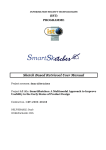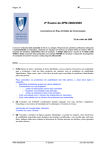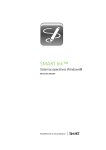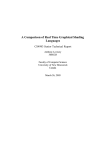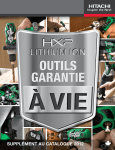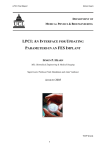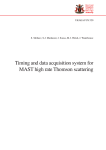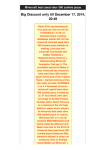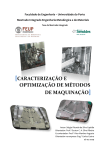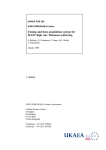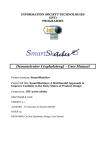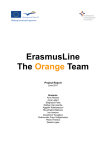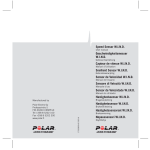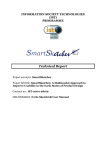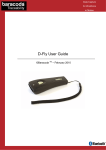Download GIDeS++: A Rapid Prototyping Tool for Mould Design
Transcript
GIDeS++: A Rapid Prototyping Tool for Mould Design Joaquim A. Jorge Nelson F. Silva Tiago D. Cardoso Dep. de Eng.ª Informática IST/UTL Av. Rovisco Pais, Lisboa [email protected] Instituto Superior Técnico Av. Rovisco Pais, Lisboa [email protected] Instituto Superior Técnico Av. Rovisco Pais, Lisboa [email protected] João P. Pereira Dep. de Eng.ª Informática ISEP/INESC R. de São Tomé, Porto [email protected] Abstract With the advent of new interaction techniques and supporting hardware we should look beyond traditional WIMP (Windows, Icons, Menus, and Pointers) interfaces. Mouse and keyboard are by far the most widespread input devices and have been around for a good many years. However, before these, designers have been using pen and paper for an even longer period. Indeed, the first 3D drawings were sketched from simple perspective drawings. In this document we describe GIDeS++, a tool that adopts the paper-and-pencil metaphor to bridge the gap between designers’ and modellers’ innate ability at freehand drawing and the more elaborate and structured methods required by traditional CAD systems. GIDeS++ offers handwriting recognition for both gestures and measures, combined speech recognition as an alternative to floating toolbars and a set of innovative, simple and efficient tools that allow for quick prototyping and modification of three-dimensional shapes. GIDeS++ has been developed in close contact with modellers from the mould industry to derive a robust, powerful, yet natural and simple application that runs on a Tablet PC to allow for "on-site" prototype creation. Further, using a mobile platform should also ease discussion with clients. Keywords Mould Design, Prototyping, Interaction Techniques, 3D Modelling, Sketching, Gesture Interfaces, Calligraphic Interfaces, Handwriting Recognition, Voice Recognition. 1. INTRODUCTION The evolution of computer-aided design systems has been characterized, amongst other aspects, by the fact that its remarkable increment in functionality was obtained at the cost of an undesirable increase in the complexity of its use and of a consequent distance in relation to traditional paper and pencil. The abundance of existing commands and the strictness of the interaction tend to interfere with the designer’s mind and disturb her/his creative processes, so it’s not surprising that users continue to rely on paper and pencil in the initial stages of the design, resorting to computers only in the final stages, when the shape of the object being created is already established and it is important to convert the sketch into a precise drawing. There is, therefore, a gap between paper and pencil of simple and passive use on the one hand, and the complex and less natural professional CAD systems on the other. GIDeS++ (Gesture-based Interactive Design System) intends to fulfil this gap in two different ways: first, by adopting sketching as its main interaction paradigm, it allows modellers to draw in the same natural way they usually do when they use a pencil and a piece of paper; second, by providing precision mechanisms such as geometric constraints, construction lines and measuring, it gives users the ability to create substantially complex and precise technical drawings. With only a pen the user is able to create primitives by issuing simple gestures. These objects are positioned in an intelligent way relative to existing ones. Most operations are implicit in the sense that the system attempts to “guess” what the user is trying to do. Moreover, having a suggestion mechanism allows GIDeS++ to minimize user’s actions and allowing freehand drawing gives a very natural feel to the whole process. All common manipulation tools are present but with new improved features. Effort was put into developing high- level tools that take the user away from the common control-point manipulation approach. Still, if the work is to be used it must be accurate so the system is complemented with a measure system that allows quick setting of object sizes and thus one is able to export the models created to any CAD system for further work. On top of this a multimodal interface was developed, featuring voice-recognition for invoking commands as well as handwriting recognition for writing down measures of objects. Replacing a more conventional WIMP interface with this kind of user input gives this system an edge regarding quick prototyping of models. 2. PREVIOUS WORK A system like GIDeS++ presents several innovative concepts and some of these had already been thought out so merits go to previous work done by very creative people. As stated before, the main reference for this project is an older version of the system developed by Pereira: GIDeS [1]. It was a calligraphic RISC interface for a modelling system built upon the IRIT modelling kernel. Several interesting and original ideas were presented in this application, from the ambiguity solving expectation lists to very simple and powerful tools like cutting and gluing that provide high-level operations with a very natural interface. 3. EXPECTATION LIST On the most noticeable solutions that resulted from the development of this system were Expectation Lists (Figure 1). designers, the following stage consists of having a specialized CAD technician to take the product of this conception phase, which is usually drawn in freehand, and port it to an exact computer three-dee model. By providing a more natural and pleasant, interface instead of the traditional WIMP ones found in commercial packages, one hopes to close this gap and “build” a bridge between these two stages, motivating designers to draw free-hand directly on a CAD system, allowing them to quickly prototype models that can easily be changed to follow the so usually strict requirement measures and constraints. 5. MEASURES LAYER Being a sketch-based modeller, no precision in the object creation input can be assured. Unlike other CAD systems, where dimensions of objects are defined as they are being constructed, GIDeS++ 3D primitives are assembled from strokes, which can’t guarantee any precision when it comes to measures. Even with the help of some kind of ruler or a grid with defined unit size, the user cannot be accurate enough. One efficient way to define proportions, but not real measures, is to use support lines with geometric constructions. Even though this is of great help and has an enormous potential, it doesn’t unravel the entire problem. Taking this into account, one possibility to resolve it was to create a special layer where the users could check edge’s dimensions and other object measures and be able to change them as well. There were a few intricacies in the construction of the interface that would allow the user to do such things. Firstly, how would the user change to this layer? Would there be any explicit information that would point us out how to do so? And then, the other logic questions, how could an interface that would both maintain the naturalness be created, following the paper sketch analogy but always having in mind that the less activity the user needs to do, the better! Figure 1 – Expectation List These allowed the system to deal with the ambiguity of the input provided by user strokes by displaying a list of the possible most likely interpretations given a certain context, behaving as a RISC application, with a small amount of commands and a high set of possible operations, as it is seen on Figure 1 above. These non-intrusive context-based dynamic lists free users from memorizing modelling gestures and constructs. 4. MULTIMODAL INTERFACE Intelligent Multimodal Interfaces have come a long way and are currently being applied with success in many areas. Providing an interface that enables a user to interact with a system in a more natural way is one of the main goals of this upcoming research subject. Looking at the usual workflow of any manufactured piece one can see that most of the creative work is done by Staying in the measures layer is obvious that the user wants to visualize as easily as possible the object’s dimensions. The first approach to this problem was to show every edge measure from a selected object. But soon enough one realized that this was too much information and could even be impossible to show it all at once. It was also noticed that if one knows an edge’s size, by proportion analogy, the size of the others can be easily speculated and consequently there were no reasons to report more that one measure at a time. Well, this probably isn’t entirely true, but knowing which edges were important to inform at a given moment is a much too complex and non-trivial and we would have efforts would have been wasted and other, more important, areas might have been neglected. The idea was to have a way of easily and quickly displaying an edge’s measure permitting the user to verify a vast number of edges in a short period of time. A solution was found, one that is plain, simple and efficient: as the mouse moves over and edge, automatically that edge – from one vertex to the other - is highlighted and numeric indication appears, stating the edge’s length. Finally, the only thing left was a method to allow measure changes. Initially, the objective was to copy the way designers and architects set measures. This is usually achieved by stroking two lines, both starting near vertexes and stating the measure in the middle of them. As a result, changing a measure in GIDeS++ would be performed in the same way. The user draws a line starting from a desired vertex and then from another and the length between these two vertexes would come into sight. Posterior to this, the user would specify the new length and the change is performed. As another possibility, the users can simply ignore this measure and continue to perform other action, enabling the visualization of distances between vertexes not linked by an object edge. Still the user had always to stroke two lines and just then would he be able to make any changes. So and keeping in mind that simple and easy is better, a complementary way of setting measures was implemented. Simply by clicking over an object’s edge, the user is allowed to change it. Of course this solution only has some vertexes combinations in mind, but we could always recur to the previous technique for others. A particular and important moment was when the user would specify the new length. The use of the keyboard was out of the question as this application was, since the beginning, thought to be interacted with non-conventional input like mouse or keyboard. Showing a little numeric keyboard in a frame with special characters like coma or point wasn’t very convincing, stylish or even efficient. The logic way was to turn to handwriting recognition. This was the most natural, pleasant and efficient way to input measures. Not only is it quick, but also designers are used to write measures down on paper. Therefore, a grey frame appears in the screen and the user can simply write down the desired number. To recognize handwriting, one resorted to Microsoft’s new Handwriting Recognition that is part of Windows XP Tablet PC Edition [2]. The recognizer gives us the power to recognize, in an efficient way, human writing. Some tests were performed to test the recognizer liability and success rate. 6. VISUAL ENHANCEMENTS Visually, several changes were introduced since the first versions. It tries to create a more pleasant visual environment, which can be catchier and more enjoyable for the user. The first noticeable differences reside on colour changes, such as the background and user stroke and remaining lines. Some other changes were introduced in the visual feedback provided as a result of user interaction. As for the Expectation Lists, we concluded that imposing the upper-left position on the screen had many disadvantages and could turn the experience of selecting a suggestion into an annoying process. Consequently, it was changed so that the user could move it around like a floating frame and every time this list appears, it is displayed in the last place it was left. Another enhancement, resulted from usability tests conducted in Marinha Grande, was the possibility of positioning the list near the mouse cursor and applying transparency in order to better integrate the list with the environment and be less intrusive. Objects were also part of the “face-lifting”. One wanted to create a use experience that resembled somehow computer games, which try to be attractive and visually appealing, involving the user in a deeper level. As part of this plan, some graphic effects were added enriching not only the application’s aspect, but also the visual information received by the user. The first effect applied was Motion Blur to camera view changes. When a determined view angle is chosen an animation is performed, changing the camera’s orientation and zooming on the desired entity. During the animation, the well known motion blur effect provides realism since humans see real life in this manner and gives better notion of how the camera is moving and in what way is the scene being watched. Another effect was applied to object selection. When an object is selected, a glow effect appears, highlighting the object. This is not only stunning and elegant, but this glow has the particularity of being present even when the object is behind another. A sort of ghost object appears when the object hides at the back of another, enlightening the user about its position, orientation and about its shape. This information can be important when using real time object manipulators, like real time rotation or translation, since one can follow the object at all time, allowing adjustments to the object even when it is under another one. When performing Boolean operations, this effect could be of a great help too, as one can watch an object part inside the other, seeing, if it is the case of a subtraction or intersection, what will result from that operation. Finally, as the camera point of view changes and a part of a selected object gets behind another one, we can still see it, allowing us to see all objects while changing the view, without moving the other object or isolating the selected one. 7. SHADING TECHNIQUES While most systems aim for realistic rendering techniques, these might not be the best of tools for modelling purposes. Perhaps a new, different kind of shading would allow modellers to focus on the overall geometry of an object and its finer details. Trying to withdraw some conclusions one decided to develop some examples of both of these techniques by providing shaders with special secular components, for giving some simple light refraction effects, and others with only diffuse component but presenting an object’s silhouette and creases to the user. description of these new tools is presented next in their finished and ready-to-use version. In order to experiment with these realistic and non-photo realistic rendering techniques, greater control of the graphics pipeline had to be achieved. Recent advances on GPUs (Graphic Processing Units) allow one to harness and use all its processing power. Still, until recently this could only be done by coding shaders in Assembly language. Shading code written in a high-level language is much easier to read and understand. It also allows new shaders to be easily created by modifying previously written shaders. Figure 3 – 2D Constraints For starters, 2D Constraints were added. These particular Constraints are merely constructive as one isn’t able to directly manipulate sketches. For this reason and as showed in Figure 3, they were put in the expectation list. After the user drawing a stroke, if a constraint is perceived, the result will be introduced in the suggestion list as one more possibility. The set of possible constraints - parallel, perpendicular, tangent and tangent-perpendicular lines - is operational and can be of great help to designers when making precise drawings. Ideas were maintained for 2D/3D constrains. The feedback is similar, being the only difference the fact that now edges and faces of object act as restrictive agents and not the 2D graph itself. Figure 2 – Shading techniques examples So one had to look into the available high-level shader programming languages available. There are, at the present time, two major options: Cg [3], developed by nVidia and offered to the OpenGL ARB, and HLSL, which was created by Microsoft and can be used only with DirectX. Since the graphics library used by GIDeS++ is OpenGL, Cg was the obvious choice and it is very well documented and as, in fact, been used in several computer graphics courses as an invaluable tool for teaching all about illumination and shading techniques. At the present time, as one can observe in Figure 2, both thin film technique and toon shading are already implemented and can be mix in the same scene even with the hidden line rendering that shows object’s edge even in occult parts. 8. CONSTRUCTIVE CONSTRAINTS Many new features, most of them regarding constraints, were designed and put in line to be implemented. A Regarding object manipulation on a more edition level instead of merely constructive, new features were also added. Firstly and most important, the section manipulation tool adds a new interaction process. This new process reassembles direct manipulation and a preview of a possible final result is shown real-time. It only reassembles direct manipulation as the object isn’t actually changed until the action is committed and it still depend on sketch because the user interaction is analogous to an indication of “this edge putted here” by drawing a line and therefore changing the section size. Still this was different enough from the pure-sketch scheme and so it had to be validated. Figure 4 – Hole Section Manipulation Figure 5 – Section Manipulation In Figures 4 and 5 one can see the interaction with section manipulation operator. Firstly, the user picks the wanted edge/section to change, and then a preview, presented in the figures, will appear showing the result in the main working face. A special-effect animation will mark the original section and an animated arrow will spot from the centre of the section till the cursor. Along with these two indications, the top surface is also extended so that the user can preview its final look and be assuring of the result. If this extension overlaps the surface itself then the portion that will disappear with when committing will show up in another colour, which is blue by now. In a more technical approach, the result of this operation is an offset of the remaining face of the section. Besides the top and main face, where the preview will show up, other faces connected to the section will offset to fulfil the preview and the remaining faces will morph to close the object and connect to those offset faces. The user can then enlarge or shrink a section by pulling it, enabling more control and more edition-power over objects. Being holes so important to moulds industry, it’s crucial to be able to edit them as quickly as possible and with the great amount of control as possible. This operation is then a successful step towards the goal. Following the same kind of interaction, a new tool, Move Sections, was also devised. It allows for quick repositioning of object’s portions, meaning that holes can easily be moved along the face they’re caved in. With these two tools, mould modellers have the ability to discuss cold runners and injection holes size, position and overall specifications online with customers, bringing a slight edge in comparison with conventional cad systems. Generalizing this notion, almost any component of an object can be easily and quickly erased, having therefore independence between them. An object’s component isn’t just considered an object’s bumps or holes; it can be a top face, a hole’s bottom, a corner fillet, a chamfer or anything else that by common sense can be taken out. Some examples of this tool’s potential can be viewed in Figure 6. The top examples result both in a simple box, however the other two illustrate a particular case and its result. Finally, the last but not least new feature is equal-sized edges operation. Until now, making two edges have the same length was a two-step process. One had first to view the measure for the source edge, and then select a destination edge and input the right size. 8.1 Usability test and results Upon implementing all these new features, a new GIDeS++ prototype was developed. There was the need to test and evaluate it, so a usability test took place at CENTIMFE’s headquarters, in Marinha Grande, Portugal, on the 26th of March with the participation of five users with different experience and task in mould industry. This usability test had also in agenda the validation of different kinds of non-photorealistic rendering and the expectation list as a way of dealing with ambiguity. Users found the list to work better when it is presented immediately near the cursor. This is a different approach to the one in the previous GIDeS versions. On top of this a new conclusion was drawn from the tests, there must be a quick way to show/hide the list since once one is accustomed to the system it might be more of an obstacle than a help, as one “learns” to have the first suggestion right. Furthermore, transparency proved to be a natural way to better integrate the list in the working environment. All these changes to the list will enforce us to take another approach at it. In what regards constraints, the feature that caused the greater impact was delete holes as this proves very simple and efficient and a valuable aid in mould modification. Figure 6 – Delete Tool Another feature introduced, within object space, is holes deleting tool. This new tool has the potential to remove a hole by scratching over it. Regarding the interface, this follows another idea. As scratching was already used with great success in deleting other entities, like lines or objects, it was only common sense to continue this kind of interaction to any other deleting tool as long as possible. Another aspect notice was the higher rating added by Hole Section Manipulation over Section Manipulation. This only accentuates the importance of holes in object edition. On the overall all new features were very welcome and received high marks and most comments concerned only to small details regarding the interface or visualization. Concerning shading techniques, it is easy to conclude that CAD technicians welcome any new rendering method. Perhaps tired of the dull interfaces found in usual CAD applications, photo-realism is the most appreciated, as it can give them a better notion of what the final product will look like. At least one non-photo realistic and one more realistic should be present, thus allowing users to have a more simplistic view for use during the modelling process and a more detailed one which can be used for details and realistic preview. Another important result drawn from this evaluation session was that hidden lines are without doubt a plus to GIDeS++ as it gives better perception of the object as a whole. To sum up, all expectations for this evaluation session were fulfilled and even surpassed, unveiling the right path of development of GIDeS++ in near future. 9. CONCLUSION Porting of the old GIDeS system was successful and the new version introduced several enhancements regarding its architecture and modularity. Thus, if furthers modifications are to be made it certainly is now a fairly easy task. Regarding the overall functionality it is clear that the existing gap, between the design and modelling stages of a production process, can be shortened by this system. The free-hand drawing allowing simple sketching of three-dee models, allied with the new measures layer allows for designers and modellers to use a common tool, where a prototype can be created and exported to inhouse CAD systems. Delegating a major role to holes proved to be a right choice as mould creation becomes easy to built and modify, even in real time with clients. On top of this, the whole new multimodal interface also brings a set of new features to GIDeS++, specially the handwriting recognition, which is a clear case of success. Voice recognition would allow for an interface with no toolbars or menus whatsoever but users were not that comfortable with it and it is regarded as an alternative [4]. Still, it was also well accepted and with good results. On the overall, GIDeS++ is developing in the right direction and at a great pace, bringing together rapid prototype development and CAD precision and power. 10. ACKNOWLEDGMENTS The work described in this paper has been supported in part by the European Commission Grant #IST-200028169 (SmartSketches project) and by the Portuguese Science Foundation under grant POSI/34672/SRI/2000. Further thanks go to all testers of the GIDeS++ system, including modellers from CENTIMFE as well as friends and colleagues. 11. REFERENCES [1] Pereira J. P., Jorge J. A., Branco V. A., Ferreira F. N.: GIDeS: Uma Abordagem Caligráfica à Edição, 9º Encontro Português de Computação Gráfica, 2000 [2] Microsoft Tablet PC Platform SDK Documentation, http://msdn.microsoft.com/tabletpc [3] nVidia: Cg Toolkit – User’s Manual, http://developer.nvidia.com/page/cg_main.html [4] J. Jorge, N. Silva, T. Cardoso, GIDeS++, 12º EPCG, 2003






